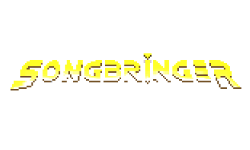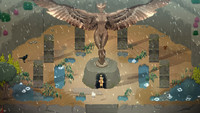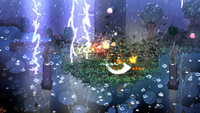|
|

|
PLATFORM
|
PS4
|
BATTLE SYSTEM
|

|
INTERACTION
|

|
ORIGINALITY
|

|
STORY
|

|
MUSIC & SOUND
|

|
VISUALS
|

|
CHALLENGE
|
Moderate
|
COMPLETION TIME
|
Less than 20 Hours
|
|
OVERALL

|
+ Unique sci-fi twist on classic fantasy formula
+ Frantic hack-and-slash combat is satisfying
- Visuals a bit too chunky, music too forgettable
- Story could have used more time to shine
|
Click here for scoring definitions
|
|
|
The ideas for Songbringer sound solid on paper. Make a randomly generated, three-quarter perspective game in the vein of the original Legend of Zelda, albeit with locations, dungeons, bosses, and items placed in different locations each playthrough; adhere to old-school aesthetics; infuse the narrative with sci-fi elements; and have some hidden secrets for players to find. The very idea of a game that captures the feel of that classic experience was enough to catch my attention, right from the moment I got a chance to go hands-on with it at E3 this year. In practice, however, not everything comes off without a hitch, as there are some hiccups along the way that result in some big-time missed opportunities in an otherwise enjoyable game.
Players take on the role of Roq, a member of the spaceship Songbringer's scouting party, who finds himself stranded planetside during a routine recon run, surrounded by hostile creatures and mysterious monoliths. It's up to Roq, with his floating robot sidekick Jib, to survive this alien environment, unravel what happened to its previous inhabitants, and discover what lies behind the mysterious horned apparition that seems to want to lead him on his journey. While the narrative setup holds some promising nuggets of potential, especially in regards to uncovering the planet's backstory, plot is dispensed piecemeal and in broad strokes, which keeps it from becoming a satisfying part of the overall experience. What's more, the narrative does very little to impact the actual game; it could have been cut completely without much of a detriment. It's nice that an attempt has been made to provide some depth, but by the time the credits roll, it's clear that more was needed to leave a lasting impression.
The game's narrative is also undermined by one of its primary selling points: the inherent randomly-generated design. Songbringer's eight-by-sixteen world grid is laid out based on a random-letter seed entered by the player when starting a new game, and sports a total of ten dungeons, nine of which are accessible from the main world map. Since the location of dungeons is different in each seed, it's highly improbable that any gamer will visit all of them in their proper, numbered order. The two final dungeons are the only ones that cannot be entered without the proper item; all other dungeons can be played in any order and, in several cases, even beaten with start-game equipment. The ones that require a certain item are typically not gated until just before the boss, meaning players may need to slog their way through all over again once the requisite items are acquired. Moreover, story progression seems linked to dungeon completion, so if dungeons are played out of order, it breaks up the natural flow of the narrative. In my case, dungeons one and two were the last two discovered, after I'd already spent several hours uncovering most of the map, meaning the majority of the story ended up shoehorned into the last quarter or so of my gametime.
 Nothing foreboding about this dungeon at all.
Nothing foreboding about this dungeon at all.
|
|
To be fair, it's almost impossible for Wizard Fu, the one-man development team of Nathanael Weiss, to account for every possible world seed out there. A little harder to look past, however, are the times Songbringer becomes frustrating not due to its random layout but due to the game failing to provide crucial directions for essential gameplay functions. Chief offender on this list is the game's item synthesis mechanic. Accessible once the player has discovered one of the game's elements — fire, ice, acid, fear, and lightning — and regains the ability to warp to Songbringer, weapons and armor can be infused with an element to create unique combinations that add offensive or defensive bonuses, and are necessary to get around some of the dungeon roadblocks. The trouble is that this mechanic is never explained or mentioned — not at the game's outset, not after it becomes accessible, and not when it's needed to complete a dungeon. Figuring out where to go to synthesize items is a matter of deduction, but knowing how to do it once there is left up to the player to figure out. Others may have been able to figure it out more easily, but a simple tutorial textbox would have prevented me from spending a considerable amount of time backtracking, certain that I had missed an essential item somewhere along the line.
Another example comes when the player frees Vell, an AI-controlled character who will fight at Roq's side from that point on. Once found, she demands to be taken to "the tower," without providing any hint of where it might actually be — incidentally, the world map includes no tower-like objects — and protests whenever Roq takes her along to any other dungeon. As it turns out, the tower is actually the final dungeon, which is gated from entry without the proper item. The result is an NPC steering the player to a presently impossible-to-reach location, rather than providing helpful information, or even just staying blessedly silent. Again, it's the small things that really add up to give Songbringer an extra, unnecessary layer of frustration.
Thankfully, the heart of the game — its combat — is fluid and fun, if a bit on the simple, button-mashing side. After finding a sword right on the game's first screen, in an obvious homage, Roq will find several other items over the course of the game to help him best the challenges the world of Songbringer has in store. These include bombs, a passive energy shield that absorbs initial damage when standing still, the ability to throw his top hat for ranged damage, the power to "blink" a few feet to get out of the way of incoming attacks, and other items that strengthen his arsenal. The aforementioned ability to synthesize elements to the various weapons lets each player tune offensive capabilities to his or her liking. Even with this customization, the combat rarely gets more nuanced than "enter room, mash attack button," with the exception of boss fights. Additionally, some dungeon rooms are packed wall-to-wall with foes, leaving little room for breathing, let alone strategy. Still, combat has a satisfying edge, from the thrill of clearing a room of overwhelming odds to the responsive sound cues of his sword slicing through enemy hordes, and Roq's arsenal is accessibly mapped to the different face buttons when playing with a controller. Damage can be a bit tricky, as the three-quarter perspective often makes being hit by enemies unavoidable. Bosses, especially, present decent challenges that are fun to figure out how to correctly approach and take down. By contrast, the overworld's respawning baddies are much more lackluster, and can thankfully be avoided entirely by running past.
 Flashy particle effects in all their pixelated glory.
Flashy particle effects in all their pixelated glory.
|
|
Songbringer not only evokes the feel of a classic Zelda game, but is also presented in a highly-pixelated graphical style, though it felt like a bit of a mixed bag in this case. Where Roq and the other NPCs are concerned, it works well. Roq is fairly expressive, and his combat animations are fluid and easy to read. Enemy designs, however, suffer from the low pixel count, as well as a general lack of variety. Many are simply different-colored blobs and spheres of varying sizes, with the smallest ones often being difficult to track on a screen filled with particle effects and debris. The overworld features weather conditions such as rain of varying intensities, which needlessly add more to the on-screen goings-on. Add to that little glowing specks of light that hop around, probably some sort of insect, and the screen has a tendency to be extremely busy. However, lighting and particle effects are nice, and add some flashy variety to the graphics. Music is featured throughout the game, albeit only a small handful of tracks, and never rises to any loftier heights than "background tunes."
For those wishing to extend their game experience, Songbringer does offer some additional features that complement its combat-heavy focus. For experienced runners, a permadeath mode is made available from the outset, with an on-screen timer for speed-run challenges. Of course, multiple playthroughs are encouraged by the world seed system, with special seeds available to alter the experience in certain ways. For example, one seed replaces Jib with Vella right at the game's outset, affecting how certain parts of the game will play out. Trophies also exist for those who are able to complete the game without acquiring the sword or purchasing upgrades of any kind. Though the standard single-player campaign only lasts around ten hours, including full map discovery, those who've fallen in love with Songbringer will find several built-in reasons to continue playing again and again.
Songbringer was a fun time, first and foremost. It didn't change how I look at indie games or set my world on fire, but I had fun during most of my playthrough. However, I also see little reason to invest time in it after the credits have rolled — very few games get a second run-through from me these days. It isn't a game free of faults: the narrative was never more than window dressing, and the game's randomly-generated aspect really required some better guidance for essential gameplay systems. However, the main component, the game's combat, works well and is downright satisfying. Anybody with even a passing interest in classic experiences will likely find something of value here, and some will even discover a second home that they'll return to again and again.
Review Archives
|









